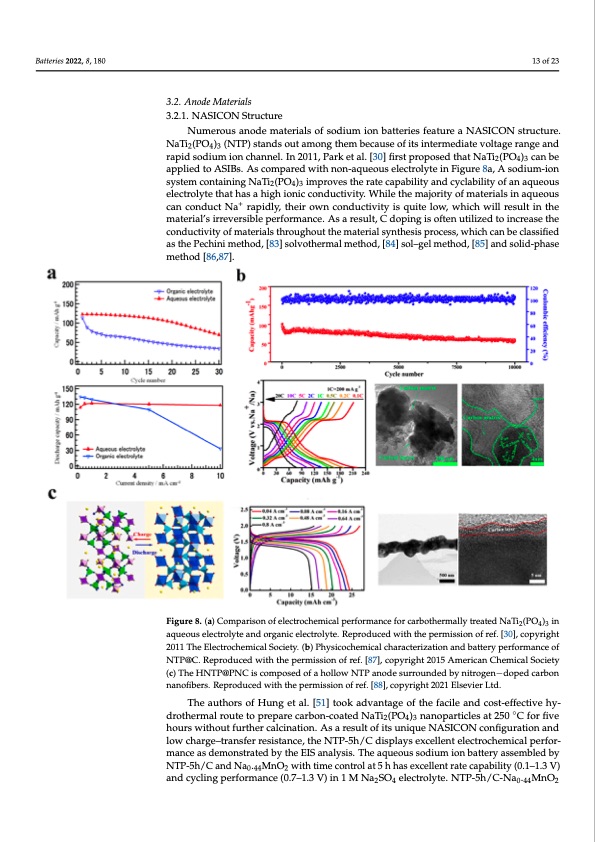
PDF Publication Title:
Text from PDF Page: 013
Batteries 2022, 8, 180 13 of 23 3.2. Anode Materials 3.2.1. NASICON Structure Numerous anode materials of sodium ion batteries feature a NASICON structure. NaTi2(PO4)3 (NTP) stands out among them because of its intermediate voltage range and rapid sodium ion channel. In 2011, Park et al. [30] first proposed that NaTi2(PO4)3 can be applied to ASIBs. As compared with non-aqueous electrolyte in Figure 8a, A sodium-ion system containing NaTi2(PO4)3 improves the rate capability and cyclability of an aqueous electrolyte that has a high ionic conductivity. While the majority of materials in aqueous can conduct Na+ rapidly, their own conductivity is quite low, which will result in the material’s irreversible performance. As a result, C doping is often utilized to increase the Batteries 2022, 8, x FOR PEER REVIEW 14 of 23 conductivity of materials throughout the material synthesis process, which can be classified as the Pechini method, [83] solvothermal method, [84] sol–gel method, [85] and solid-phase method [86,87]. Figure 8. (a) Comparison of electrochemical performance for carbothermally treated NaTi2(PO4)3 in aqueous electrolyte and organic electrolyte. Reproduced with the permission of ref. [30], copyright Figure 8. (a) Comparison of electrochemical performance for carbothermally treated NaTi2(PO4)3 in 20a1q1uTehouesEelelecctrtoroclhyetme aicnadl Soorgciaentyic. (eble)cPtrhoylsyitceo.cRhepmroicdaul cehdarwacitehrtizhaetipoenrmanisdsiboanttoefryrepf.e[r3fo0r],mcaonpcyeriogfht N2T0P1@1CT.hReeEpleroctdruochedemwicitahl Sthoecipeteyr.m(bis)sPiohnysoifcorecfh.e[m87i]c,aclocphyaraigchtetr2iz0a1t5ioAnmanedricbantteCrhyepmeircfaolrmSoacniecetyof NTP@C. Reproduced with the permission of ref. [87], copyright 2015 American Chemical Society (c) (c) The HNTP@PNC is composed of a hollow NTP anode surrounded by nitrogen−doped carbon The HNTP@PNC is composed of a hollow NTP anode surrounded by nitrogen−doped carbon nan- nanofibers. Reproduced with the permission of ref. [88], copyright 2021 Elsevier Ltd. ofibers. Reproduced with the permission of ref. [88], copyright 2021 Elsevier Ltd. The authors of Hung et al. [51] took advantage of the facile and cost-effective hy- drothermal route to prepare carbon-coated NaTi2(PO4)3 nanoparticles at 250 ◦C for five 3.2.2. Organic Materials hours without further calcination. As a result of its unique NASICON configuration and Since organic electrode materials are physically more flexible than inorganic materials, low charge–transfer resistance, the NTP-5h/C displays excellent electrochemical perfor- they are better able to accept large Na+ ions, hence boosting the energy density of ASIBs. In mance as demonstrated by the EIS analysis. The aqueous sodium ion battery assembled by addition to their natural abundance, they possess a variety of qualities that make them excel- NTP-5h/C and Na0.44MnO2 with time control at 5 h has excellent rate capability (0.1–1.3 V) lent for battery applications, including redox properties that may be adjusted, chemical diver- and cycling performance (0.7–1.3 V) in 1 M Na2SO4 electrolyte. NTP-5h/C-Na0.44MnO2 sity, mechanical flexibility, and environmental friendliness. A summary of a few representa- tive materials and their respective charge storage mechanisms is shown in Figure 5a [11]. For ASIBs, the majority of the reported organic materials are polymer materials in- cluding carbonyl compounds and conductive polymers. Polyimide has greater working voltage, capacity, and structural stability in comparison to other transient oxide anodesPDF Image | Aqueous Rechargeable Sodium-Ion Batteries Hydrogel

PDF Search Title:
Aqueous Rechargeable Sodium-Ion Batteries HydrogelOriginal File Name Searched:
batteries-08-00180-v2.pdfDIY PDF Search: Google It | Yahoo | Bing
Salgenx Redox Flow Battery Technology: Salt water flow battery technology with low cost and great energy density that can be used for power storage and thermal storage. Let us de-risk your production using our license. Our aqueous flow battery is less cost than Tesla Megapack and available faster. Redox flow battery. No membrane needed like with Vanadium, or Bromine. Salgenx flow battery
| CONTACT TEL: 608-238-6001 Email: greg@salgenx.com | RSS | AMP |